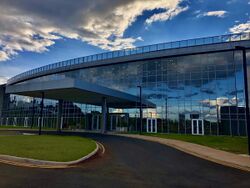Organization:Sirius (synchrotron light source)
 Sirius synchrotron lightsource building completed in November 2018 | |
| General properties | |
|---|---|
| Accelerator type | diffraction-limited storage ring |
| Beam properties | |
| Maximum energy | 3 GeV |
| Maximum current | 350 mA (currently 100 mA in top-up mode) |
| Physical properties | |
| Circumference | 518,4 m |
| Location | Campinas |
| Coordinates | [ ⚑ ] : 22°48′28″S 47°03′09″W / 22.80778°S 47.0525°W |
| Institution | Laboratório Nacional de Luz Síncrotron |
| Preceded by | UVX |
Sirius is a diffraction-limited storage ring synchrotron light source at the Brazilian Synchrotron Light Laboratory (LNLS) in Campinas, São Paulo State, Brazil. It has a circumference of 518.4 metres (1,701 ft), a diameter of 165 metres (541 ft), and an electron energy of 3 GeV. The produced synchrotron radiation covers the range of infrared, optical, ultraviolet and X-ray light.[1]
Costing R$1.8 billion,[2] it was funded by the Ministry of Science, Technology, Innovation and Communications (Brazil) and the São Paulo Research Foundation.[1] Discussion started in 2008, and initial funding of R$2 million was granted in 2009. Construction started in 2015,[2] and was finished in 2018. The first electron loop around the storage ring was achieved in November 2019.[3] Its first experiments were made during COVID-19 pandemic at MANACÁ beamline, dedicated to macromolecular crystallography.[4]
Sirius is the second synchrotron lightsource constructed in Brazil. The first one, UVX, was a second generation machine operated by LNLS from 1997 to 2019.[5]
Characteristics
Sirius is used to understand the atomic structure of molecules, which can help in the development of new drugs, new materials used in construction, oil exploration and in many other areas. The 68,000-square-meter building houses a ring-shaped, circumferential 500-meter facility. To protect people from the radiation released by machine operation, designed to be the most advanced of its kind in the world, the whole is shielded by 1 kilometer of concrete walls. Around R$1.8 billion were invested in the project, which makes it the most ambitious scientific project ever made in Brazil.
Beamlines
Currently, Sirius has 9 operational beamlines, 1 in scientific commissioning, 2 in the assembly phase and 1 the design phase.[6]
| Beamline | Main Technique | Energy Range | Status |
|---|---|---|---|
| CARNAÚBA[7] | X-Ray Nanoscopy | 2.05 - 15 keV | Operational |
| CATERETÊ[8] | Coherent and Time-resolsed X-ray Scattering | 3 - 24 keV | Operational |
| CEDRO[9] | Circular Dichroism | 3 - 9 eV | Operational |
| EMA[10] | X-ray Spectroscopy and Diffraction in Extreme Conditions | 2.7 - 30 keV | Operational |
| IMBUIA[11] | Infrared Micro and Nanospectroscopy | 70 meV - 400 meV | Operational |
| IPÊ[12] | Resonant Inelastic X-ray scattering and Photoelectron spectroscopy | 100 - 2000 eV | Operational |
| JATOBÁ[13] | Full X-ray Scattering and PDF Analysis | 40 - 70 keV | Design |
| MANACÁ[14] | Macromolecular Micro and Nanocrystallography | 5 - 20 keV | Operational |
| MOGNO[15] | X-ray Micro- and Nanotomography | 22 | 39 | 67.5 keV | Operation |
| PAINEIRA[16] | Powder X-ray Diffraction | 5 - 30 keV | Operational |
| QUATI[17] | X-ray Spectroscopy with Temporal Resolution | 4.5 - 35 keV | Assembly |
| SABIÁ[18] | Soft X-Ray Absorption Spectroscopy and Imaging | 100 - 2000 eV | Operational |
| SAPÊ[19] | Angle-Resolved PhotoEmission Spectroscopy | 8 - 70 eV | Commissioning |
| SAPUCAIA[20] | Small Angle X-ray Scattering | 6 - 17 keV | Assembly |
References
- ↑ 1.0 1.1 "Novo acelerador de partículas será inaugurado em 2018, em Campinas" (in pt-BR). Folha de S.Paulo. 19 January 2015. http://www1.folha.uol.com.br/ciencia/2015/01/1577001-novo-acelerador-de-particulas-sera-inaugurado-em-2018-em-campinas.shtml.
- ↑ 2.0 2.1 "[revista piauí A aposta do superacelerador"] (in pt-BR). revista piauí. 14 August 2017. http://piaui.folha.uol.com.br/a-aposta-do-superacelerador/.
- ↑ "First electron loop around Sirius' storage ring". 25 November 2019. https://lnls.cnpem.br/news/first-electron-loop-around-sirius-storage-ring/.
- ↑ "First experiments are carried out on Sirius". 7 November 2020. https://lnls.cnpem.br/news/first-experiments-are-carried-out-on-sirius/.
- ↑ "UVX Synchrotron Light Source – LNLS". https://lnls.cnpem.br/uvx-en/.
- ↑ "Sirius Beamlines". 31 July 2023. https://lnls.cnpem.br/beamlines/.
- ↑ "Carnaúba Beamline". 31 July 2023. https://lnls.cnpem.br/facilities/carnauba-en/.
- ↑ "Cateretê Beamline". 31 July 2023. https://lnls.cnpem.br/facilities/caterete-en/.
- ↑ "Cedro Beamline". 31 July 2023. https://lnls.cnpem.br/facilities/cedro-en/.
- ↑ "Ema Beamline". 31 July 2023. https://lnls.cnpem.br/facilities/ema-en/.
- ↑ "Imbuia Beamline". 31 July 2023. https://lnls.cnpem.br/facilities/imbuia-en/.
- ↑ "Ipê Beamline". 31 July 2023. https://lnls.cnpem.br/facilities/ipe-en/.
- ↑ "Jatobá Beamline". 31 July 2023. https://lnls.cnpem.br/facilities/jatoba-en/.
- ↑ "Manacá Beamline". 31 July 2023. https://lnls.cnpem.br/facilities/manaca-en/.
- ↑ "Mogno Beamline". 31 July 2023. https://lnls.cnpem.br/facilities/mogno-en/.
- ↑ "Paineira Beamline". 31 July 2023. https://lnls.cnpem.br/facilities/paineira-en/.
- ↑ "Quati Beamline". 31 July 2023. https://lnls.cnpem.br/facilities/quati-en/.
- ↑ "Sabiá Beamline". 31 July 2023. https://lnls.cnpem.br/facilities/sabia-en/.
- ↑ "Sapê Beamline". 31 July 2023. https://lnls.cnpem.br/facilities/sape-en/.
- ↑ "Sapucaia Beamline". 31 July 2023. https://lnls.cnpem.br/facilities/sapucaia-en/.
External links
 |


